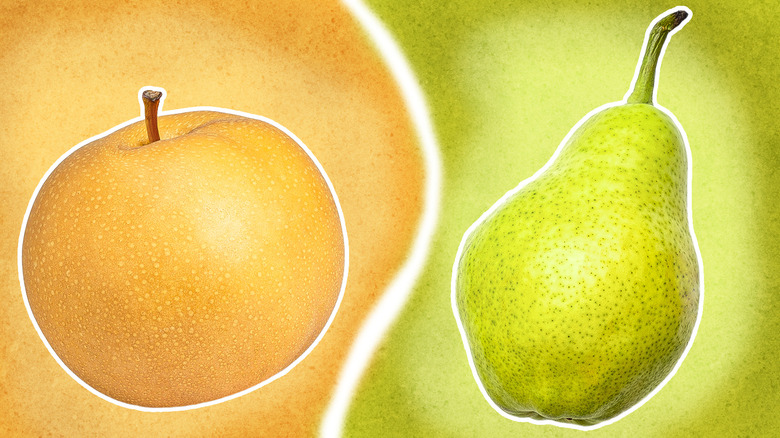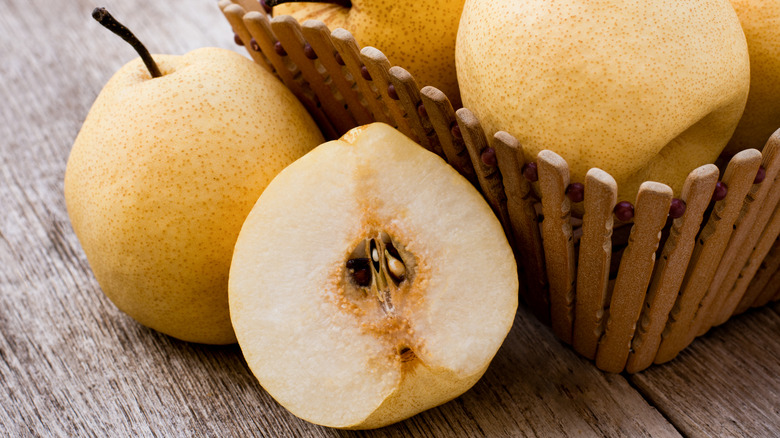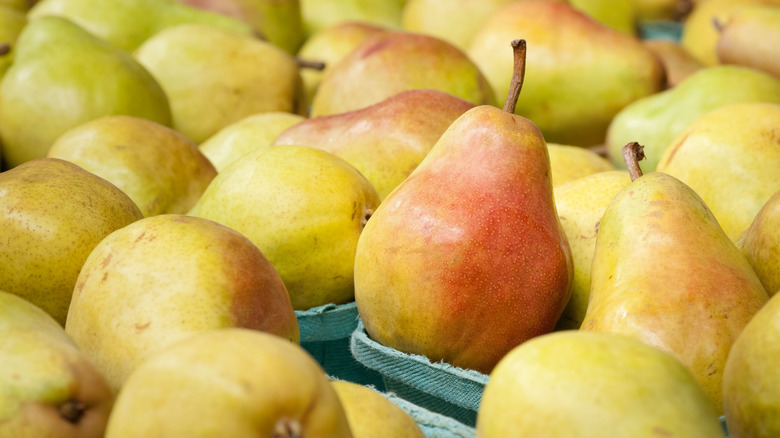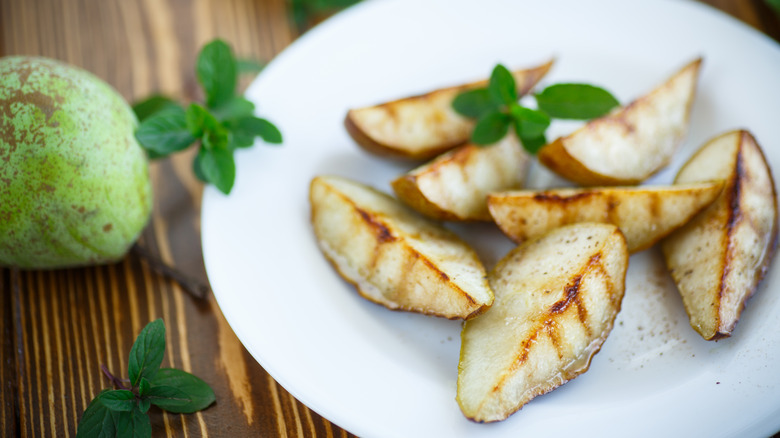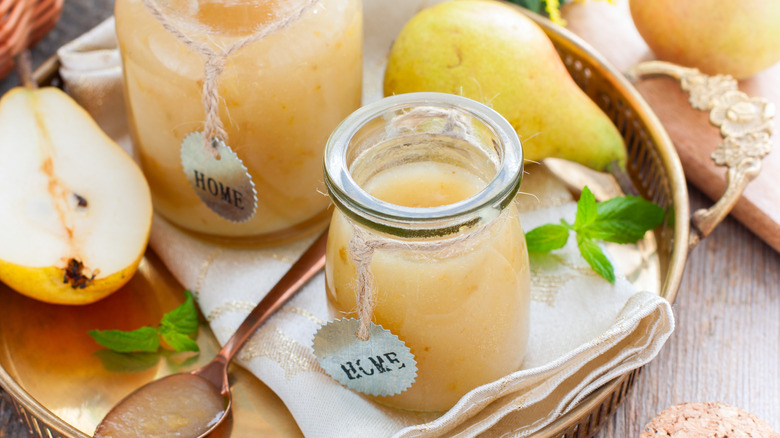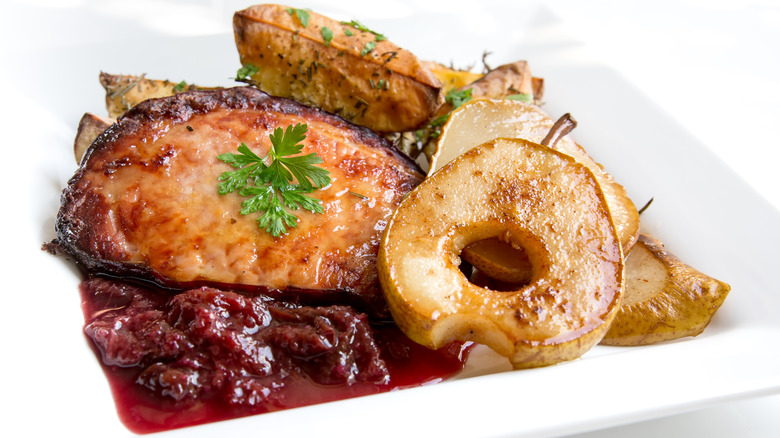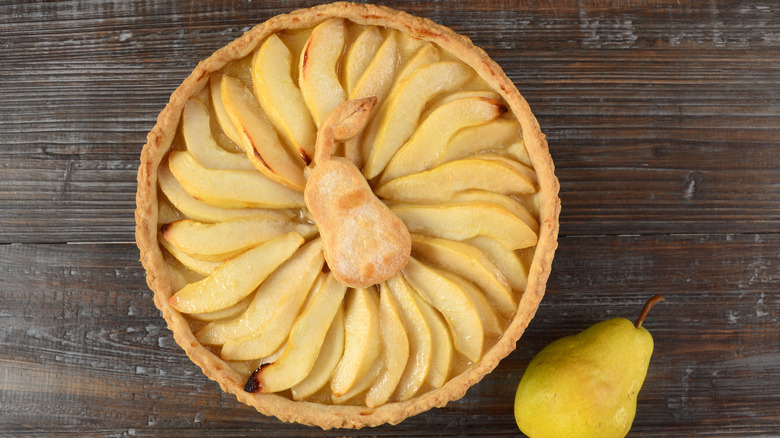Asian Pears Vs Bartlett: What's The Difference?
They may not be the flashiest-looking produce around, but pears have earned their place as delicious, multi-tasking fruits that can be used for an array of culinary purposes. Simply learning a little more about these underrated fruits' different varieties further unlocks the possibilities they offer to elevate a savory dish, a dessert, or a drink. That way, you know which one to pick if you want to add a lightly tart crunch to a salad or make a juicy, fruity filling for a tart. You'll also know which type could withstand different cooking methods so you don't end up with mush.
Among the commonly available types of pears, two of the most popular are Asian pears and Bartlett pears. While both are great for snacking raw and are widely available in the U.S., that doesn't mean you can simply swap one for the other in a dish. Let's determine which of the two will serve a recipe best by learning their respective qualities.
What are Asian pears?
Asian pear is the umbrella term for the many varieties of this fruit that are grown in the continent, whether it's in China, Korea, Taiwan, Japan, or India. The one that's frequently seen in U.S. supermarkets is the nijisseiki or 20th-century variety. No matter their source, these pears are allowed to ripen on the tree before getting picked. Asian pears can turn ripe as early as July, although September and October are the months when they generally reach their peak. Their harvest season can last until winter.
Also known as apple pears, these fruits come in a rounded, apple-like form rather than the traditional pear shape. Once ripe, their peel can come in colors varying from olive to yellow to pale bronze, with a speckled and slightly gritty matte surface. The fruit also becomes fragrant, which is a sign to look for when buying ripe Asian pears. The texture you get when biting into one is reminiscent of the crunchy juiciness of apples or jicamas. Mildly sweet and very refreshing, the pale flesh of these fruits yields floral and citrusy notes in its flavor.
What are Bartlett pears?
Known as Williams Bon Chrétien (or Williams, for short) outside of the United States, these fruits come in the quintessential pear shape and are available in two varieties: Red and green, with the latter turning golden yellow when it ripens. Much like other pears that are grown in the West, Bartlett pears are picked once they've reached maturity but are still unripe. They are then left to ripen at room temperature. Generally, their harvest season begins in late August and you can find them in grocery stores until January or February.
Beneath their smooth and delicate skins is tender, succulent flesh that offers that definitive sweet pear flavor. Bartlett pears have a slight natural tartness and buttery quality to them when fully ripe. They're delicious whether eaten raw or cooked into a dish, a factor that contributes to the continued popularity of this variety. However, Bartlett pears bruise easily and, when overripe, can become mushy.
Asian pears retain shape and texture when cooked
A unique quality of Asian pears is how they become firm when they turn ripe. This firmness gives them that satisfying crunch you get with each bite. It also helps the fruit withstand certain prep and cooking methods that other pears aren't able to.
Grate or slice them into slivers so you have something sweet and crispy to add to salads, slaws, and even stir-fries. To highlight their flavor further, grill your halved Asian pears and let the resulting smokiness add depth to their natural sweetness. Remove the seeds and drizzle some melted butter on the flesh before putting them on the grill for the best results. A sprinkling of sugar will also provide a tasty caramelization. Top your grilled Asian pears with a few kosher salt flakes and you have a delicious side dish or, when served with ice cream, a scrumptious dessert.
It might seem like Asian pears would also do well when used for baking, but due to their texture and high water content, it might be better to use other varieties. However, if you're fine with having some juice pooling at the bottom of your pear crisp, for example, then Asian pears are perfectly serviceable.
Use soft Bartlett pears for sauces, butters, and jams
Bartlett pears are traditionally considered ideal for canning. However, when ripe, they are a delicate variety that quickly falls apart when heated. This makes them perfect for dishes that call for sauces with some fruity sweetness. Upgrade your applesauce by using Bartlett pears instead of apples, and use the result for flavoring pastries, homemade ice cream, and smoothies. Cooking these soft fruits with nutmeg, cardamom, and ginger also makes a flavorful sweet and tangy butter. Slather it on your morning toast or pancakes and enjoy some different fruit flavors for breakfast. However, if you're considering using Bartletts to make poached pears, we suggest a quick rethink. One of our tips for making poached pears would be to use a firmer type, like Bosc or Asian pears.
Of course, Bartlett pears can be added as they are to dishes that could use some of their juiciness and tender texture. Place slices atop a green salad or serve them with cheese wedges. You can also dry their peeled slices with a dehydrator (skip the oven for this one) for a sweet fruity snack to nibble on. To make sure the fruits hold up their shape, choose Bartlett pears that are still firm to the touch but are beginning to turn yellow. These are indications of the green variant just starting to ripen.
Asian pear juice can be used to tenderize meat
Aside from being sturdy enough to be cooked, Asian pears also contain an enzyme called calpain, which can tenderize meat. When peeled and pureed, they can serve as a marinade for Korean beef barbecue or bulgogi. Mix the pear marinade with your choice of spices and seasoning to infuse the meat with even more flavor as it softens. The length of time it takes to tenderize the meat depends on its size, although an hour would suffice for a thin piece of beef. An added benefit of using this fruity marinade is that it adds a mild sweetness to dishes without altering the meat's taste or causing discoloration, unlike other acid-based marinades.
Just a note when cooking with Asian pears in general: While it's advised to keep the peel on when working with pears, the feel of the slightly gritty skin of this variant may not be to everyone's taste. It's best to peel Asian pears first before turning them into puree or adding them raw to salads and slaws.
Bartlett pears' high sugar content is ideal for desserts
While both types of pears have their own nuanced sweetness, Bartlett pears have a higher sugar content. They have 9.7g of sugar per 100g of fruit whereas Asian pears only have 7.1g so to infuse desserts with that sweet pear flavor you crave, go with the former. Our recipe for pear almond tart has the delicate Bartlett pear as the main attraction, enhanced by the richness and nuttiness of almonds and a buttery crust. You can also bake our soft spongy ginger pear cake and taste for yourself how complementary the flavors of both ingredients are.
When incorporating them into cooked desserts, just as we've advised earlier when selecting fruits for drying into chewy snacks, make sure to pick Bartlett pears that haven't fully ripened yet. This ensures that their flesh is still firm enough that it won't disintegrate during the cooking or baking process. Remove the cores, too, to help the fruits to cook faster, and avoid any parts that might stick in your teeth.
